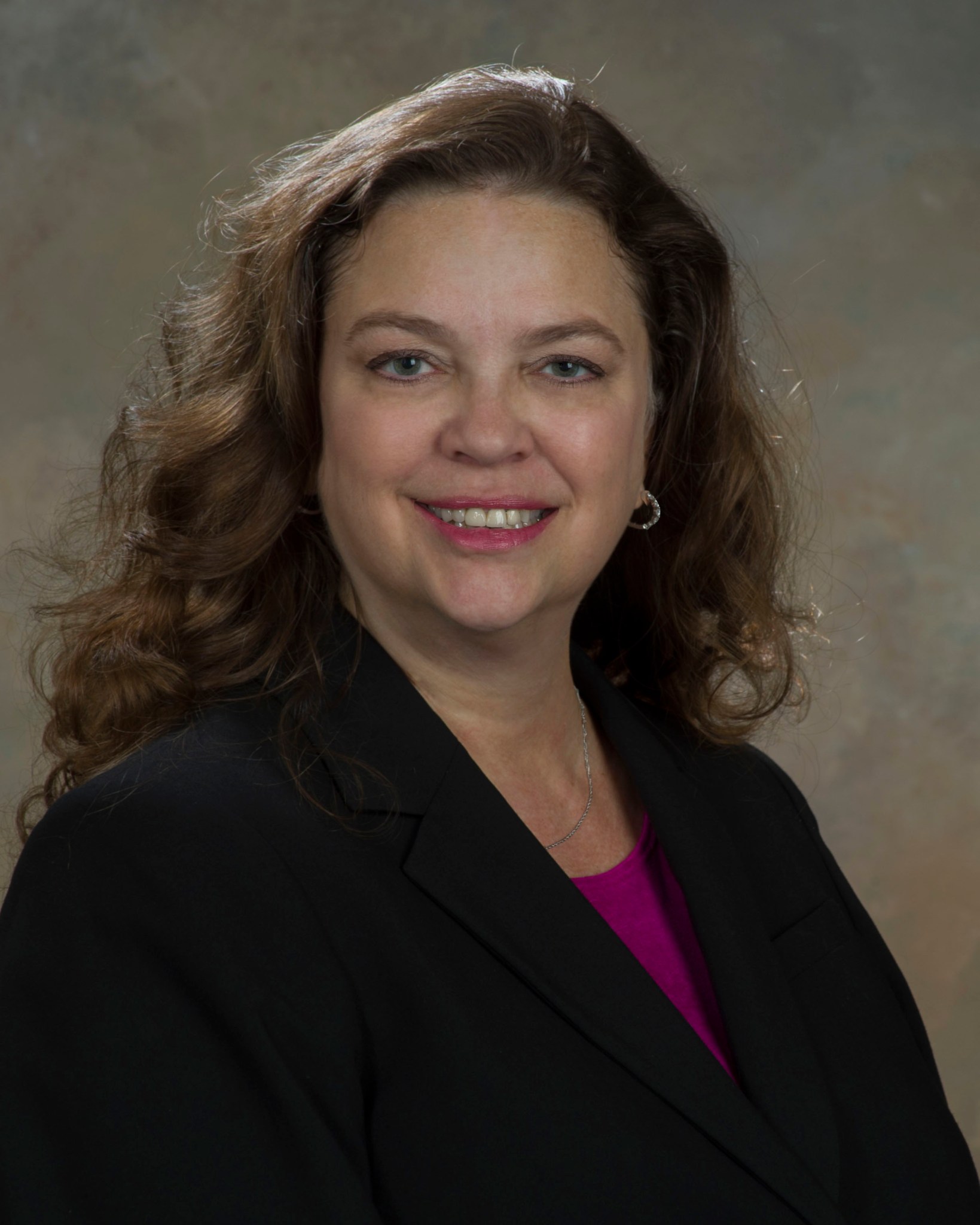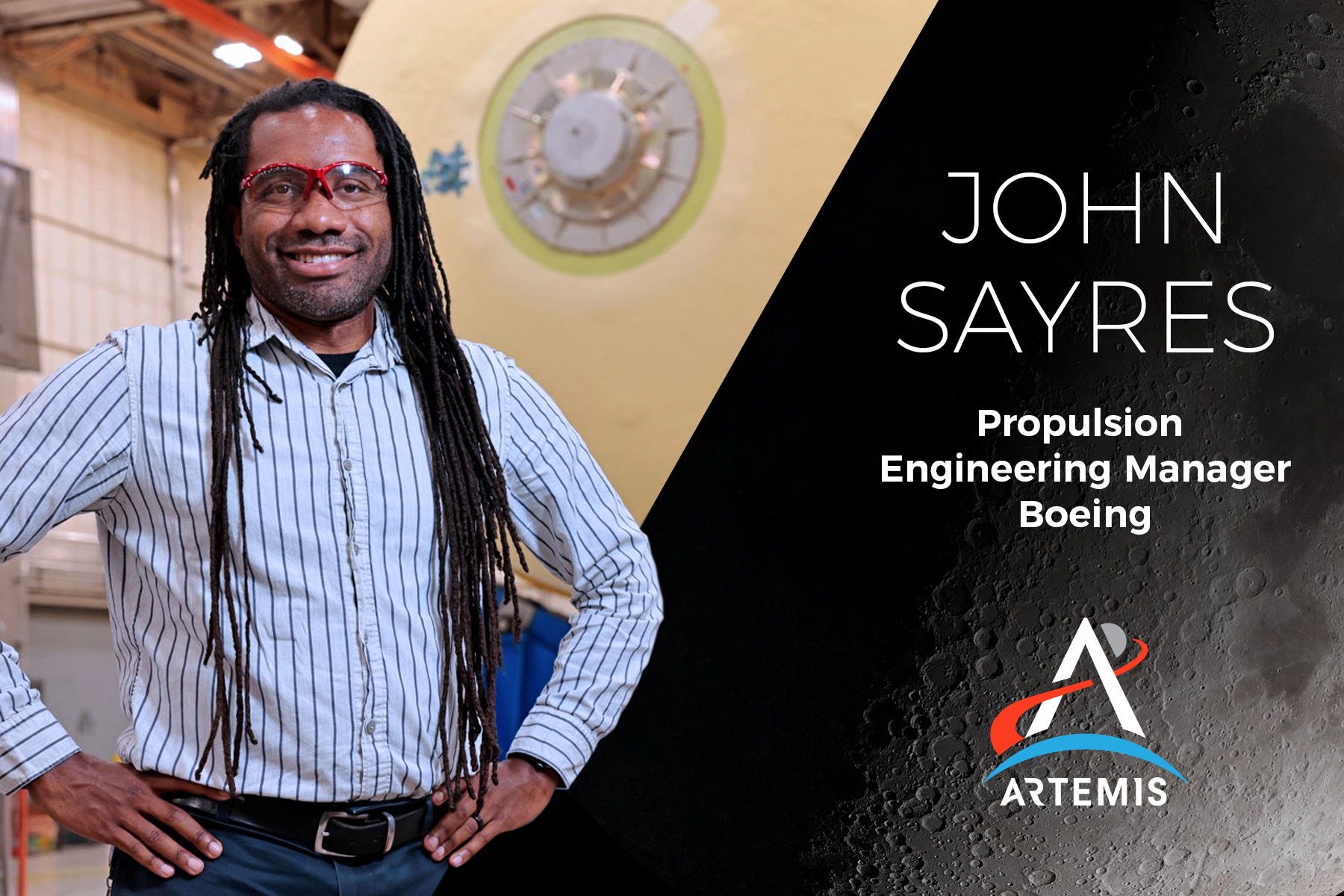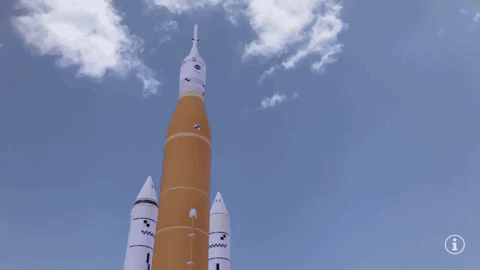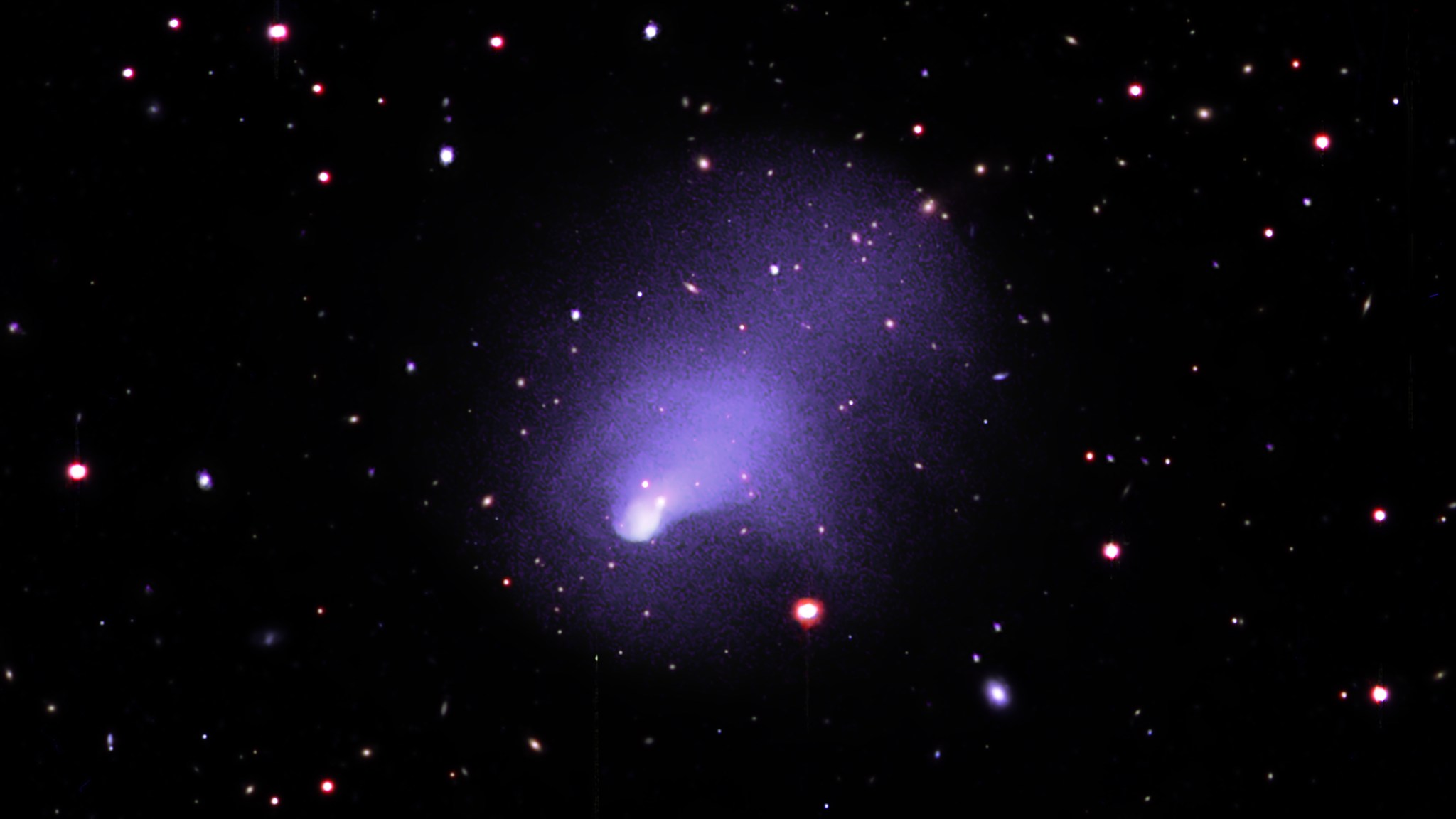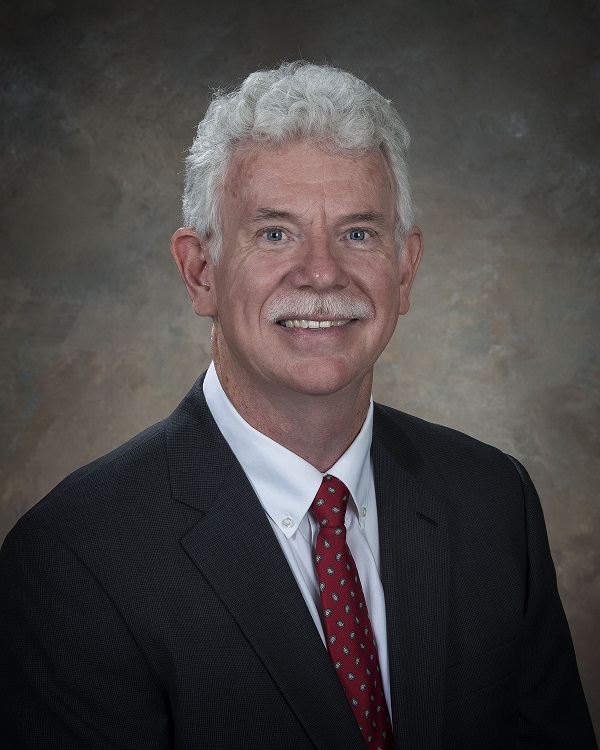NASA Concludes Artemis I Wet Dress Test
The Artemis I wet dress rehearsal ended June 20 at 6:37 p.m. CDT at T-29 seconds in the countdown. The test marked the first time the team fully loaded all the Space Launch System (SLS) rocket’s propellant tanks and proceeded into the terminal launch countdown, when many critical activities occur in rapid succession.
“Our team was on its ‘A’ game through the whole process,” said John Honeycutt, SLS program manager at NASA’s Marshall Space Flight Center. “I’m proud of how the team performed. I saw a boldness in the team that was amazing. It was great to see a full cryogenic fuel load on the core and upper stages.”
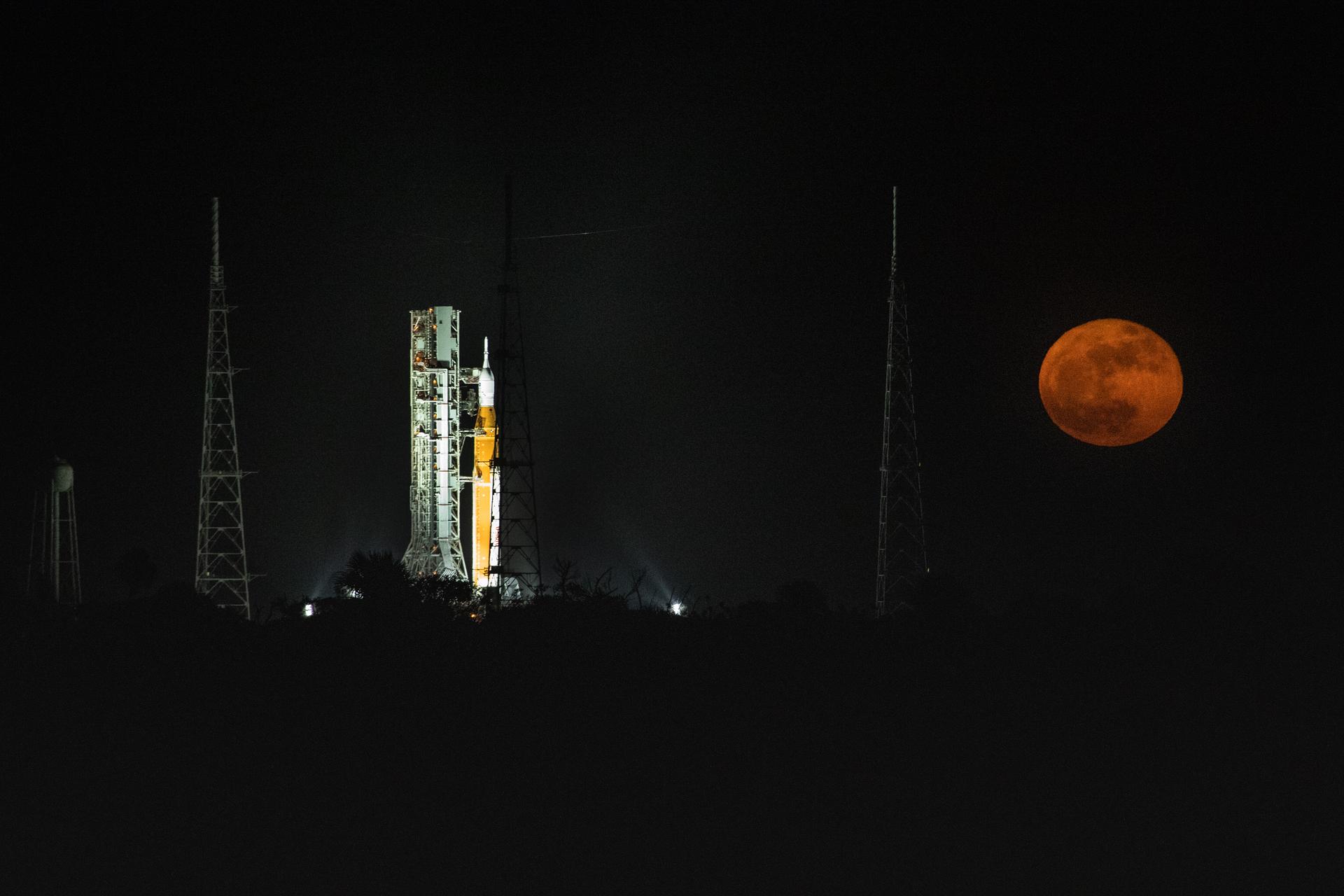
During propellant loading operations earlier in the day, launch controllers encountered a hydrogen leak in the quick disconnect that attaches an umbilical from the tail service mast on the mobile launcher to the rocket’s core stage. The team attempted to fix the leak by warming the quick disconnect and then chilling it back down to realign a seal, but their efforts did not fix the issue.
Launch controllers then developed a plan to mask data associated with the leak that would trigger a hold by the ground launch sequencer, or launch computer, in a real launch day scenario, to allow them to get as far into the countdown as possible. The time required to develop the plan required extended hold time during the countdown activities, but they were able to resume with the final 10 minutes of the countdown, called terminal count. During the terminal count, the teams performed several critical operations that must be accomplished for launch, including switching control from the ground launch sequencer to the automated launch sequencer controlled by the rocket’s flight software, an important step that the team wanted to accomplish.
“We accomplished so much, including being successful in fully loading all the rocket’s tanks with more than 700,000 gallons of propellant,” Marshall Director Jody Singer said. “In Marshall’s SLS Engineering Support Center, teams did an amazing job collaborating with teams at Kennedy Space Center as we got all the way into the launch terminal countdown.”
Through Artemis missions, NASA will land the first woman and the first person of color on the Moon, paving the way for a long-term lunar presence and serving as a steppingstone to send astronauts to Mars.
Teams Advance Preparations for Crewed Artemis Missions
While teams completed a wet dress rehearsal test ahead of Artemis I, engineers and technicians continued making headway preparing for future Artemis missions with astronauts.
The Orion spacecraft for Artemis II, the first crewed Artemis mission, was powered on for the first time by technicians at NASA’s Kennedy Space Center, where teams have been meticulously outfitting the crew module with its environmental control and life support systems and subsystems. Powering on Orion allows teams to begin verifying power and data can be routed to every aspect of the capsule. The Artemis II European-built service module is also nearing integration with the crew module at Kennedy – technicians recently conducted proof pressure and leak testing of propulsion and environmental control and life support system connections between the module and the crew module adapter, and engineers are conducting thermal and electrical closeout activities for several systems.
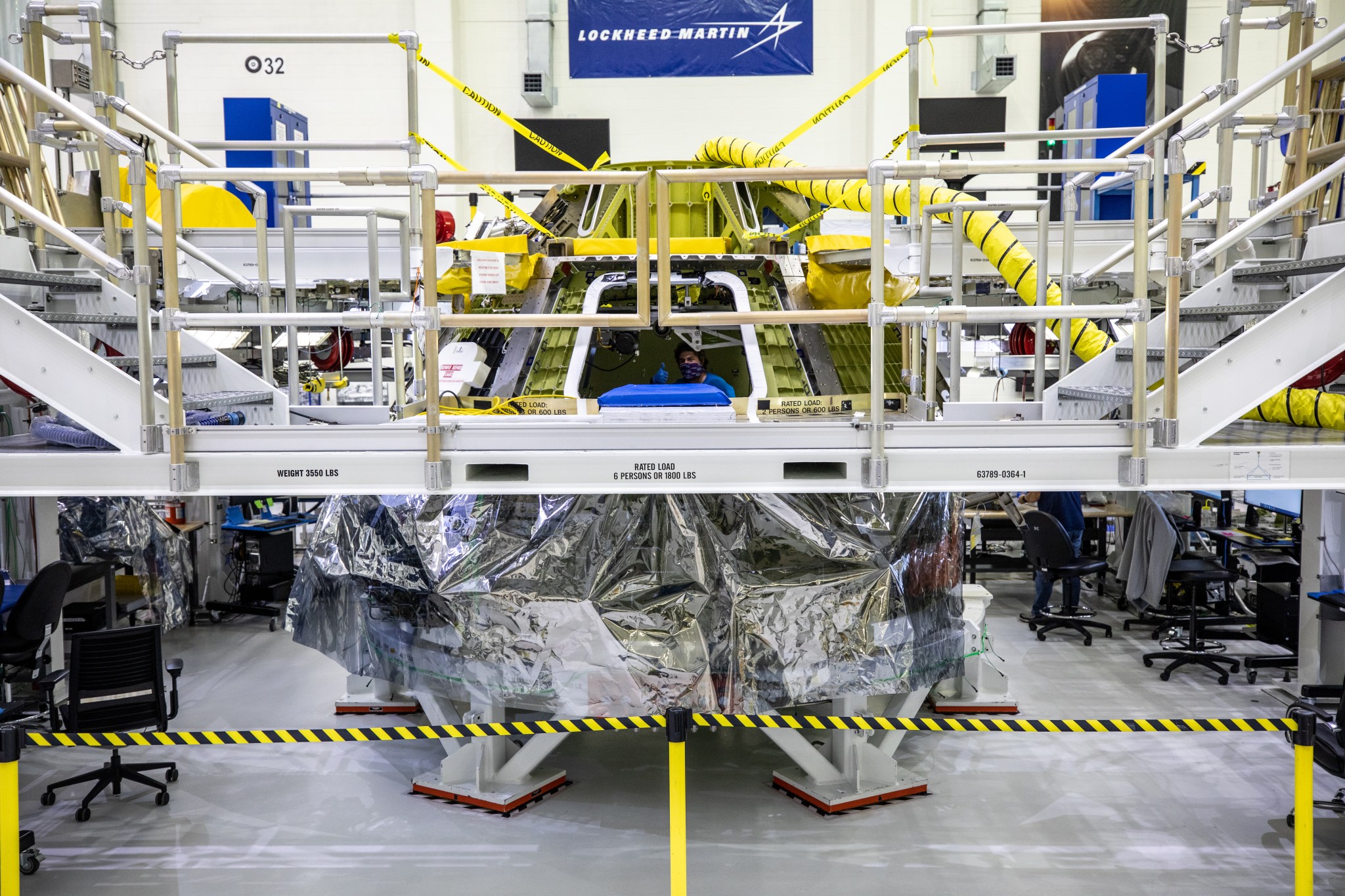
At NASA’s Michoud Assembly Facility, teams have assembled most of the Space Launch System’s (SLS) core stage for Artemis II and moved the final piece of the stage in position to complete the stage later this year. The engine section is one of the most complex parts of the core stage and contains the main propulsion systems that connect the stage to the four RS-25 engines. The engines have been assembled and are ready for integration with the rest of the stage, while the 10 Artemis II solid rocket booster motor segments are stored and ready to be shipped to Kennedy, where the rest of the booster assembly is underway. The interim cryogenic propulsion stage has already been delivered to Kennedy and is finishing final processing.
Teams also are preparing for Earth-bound aspects of future crewed missions. Canoo Technologies Inc., which will provide three environmentally friendly vehicles to transport crews along the nine-mile trip by road to Launch Pad 39B for their missions, recently visited Kennedy to kick off site-related planning activities. NASA awarded the company a contract earlier this year to supply the vehicles that will be used on launch day for crewed missions to the Moon in time for Artemis II.
As Artemis II progress continues, preparations for Artemis III are also well underway. NASA’s lead SLS booster contractor Northrop Grumman recently completed the 10 motor segments of the twin boosters for the mission, which will see astronauts land on the surface of the Moon. The segments will be kept in storage at Northrop’s Utah facility until needed at Kennedy for rocket stacking and assembly operations. At Michoud, teams also are building core stages for Artemis III and Artemis IV. The Artemis III interim cryogenic propulsion stage construction is well underway, and other rocket stage adapters for both Artemis II and Artemis III are in the final stages of production at NASA’s Marshall Space Flight Center.
Proof testing to ensure the Artemis III Orion crew module pressure vessel is sealed tightly was successfully completed at Kennedy. The European Space Agency and its contractor Airbus are preparing the Artemis III service module for shipment next summer to Kennedy from Bremen, Germany, where it is being manufactured.
Ginger Flores Named Manager of Marshall’s Human Exploration Development & Operations Office
Ginger Flores has been named manager of the Human Exploration Development & Operations Office at NASA’s Marshall Space Flight Center.
Flores will oversee management and implementation of Marshall’s work portfolio in the areas of human exploration and transportation projects; habitation systems; payload and mission operations and integration; and International Space Station payload, facility, and environmental control and life support systems project development and integration. She was previously deputy manager of the organization since January 2021.
In 2019, Flores was appointed to the Senior Executive Service as manager of the Habitation Systems Development Office and the Gateway habitation element. The Senior Executive Service is the personnel system that covers most of the top managerial, supervisory, and policy positions in the executive branch of the federal government.
In 2016, she joined Marshall’s Science and Technology Office to become acting deputy program manager and later program manager for the Technology Demonstration Missions Program Office. As a manager within the Space Technology Mission Directorate, Flores developed and demonstrated space flight technologies that infused critical human exploration, science, and commercial space missions and met NASA’s strategic mission needs. In 2015, she was acting deputy manager in the International Space Station Office.
Flores was named team lead of the International Space Station Payload Projects Team in Marshall’s space station office in 2011. She was named project manager for the Microgravity Science Glovebox at Marshall in 2008 following a detail assignment in 2007 as executive officer to the associate administrator for Program Analysis and Evaluation at NASA Headquarters.
In 2006, Flores was named associate project manager at Marshall for the Orion service module element and was responsible for planning, directing, and implementing all Marshall project activities in support of the Service Module Project Office at NASA’s Glenn Research Center. In 2003, she was a project manager in the Microgravity Research Program Office, where she was responsible for managing space station research and technology payloads.
Flores joined NASA as a civil servant in 2002 and worked as a lead cost engineer in Marshall’s Systems Management Office. Prior to rejoining NASA, Flores held management and leadership positions in the automotive and electronics industries. In 1991, she was a NASA co-op student supporting the Engineering Cost Group in Program Development.
A native of Huntsville, Alabama, Flores received both a bachelor’s and master’s degree in industrial and systems engineering, in 1993 and 1998, respectively, from the University of Alabama in Huntsville. She and her husband, Anthony, live in Huntsville.
I am Artemis: John Sayres
Growing up watching space shuttle missions, John Sayres knew from an early age that he wanted to work in aerospace. With original aspirations to do backflips in space, he realized during his college years at North Carolina State University in Raleigh that instead of going to space himself, he wanted to build rockets so that others could explore deep space.
Sayres has been a propulsion engineer at Boeing for 11 years, starting with propulsion system analysis and design work for NASA’s Space Launch System (SLS) rocket. He is based at NASA’s Michoud Assembly Facility.
Boeing is lead contractor for the SLS core stage that houses the propulsion system connected to the stage’s four RS-25 engines. The components Sayres designed – and the SLS core stage – proved successful during the rigorous testing series known as Green Run in 2021. The Green Run test series culminated in a hot fire of the core stage and RS-25 engines – mimicking real launch conditions for the components. Watching the engines fire was a surreal moment for Sayres. His own sense of accomplishment was mirrored and multiplied by all the people who had contributed to the building the core stage.
Sayres values continuous improvement, and he hopes the next generation of leaders and scientists are similarly inquisitive with an endless thirst of knowledge and learning.
“I would tell the Artemis Generation to be prepared and ask questions,” he said. “I’d also tell them to reach out for other viewpoints. Everyone can always learn something!”
Sayres’ heart for learning and advice for an open mind will be crucial as the Artemis missions progress, and it is the reason why Sayres is so excited for the future of deep space exploration.
“I recognize that the path forward involves permanent habitats on celestial bodies, which requires the collaboration and support of all humankind,” Sayres said.
When Sayres isn’t building a rocket, he enjoys playing music and testing new recipes. His family members are direct beneficiaries of his extracurricular talents, as the taste testers of his delicious creations and recipients of a music video he created at the beginning of the COVID-19 pandemic to the tune of the Beatles song “Let It Be.”
Next up for Sayres will be the biggest test yet of the SLS rocket: a launch from NASA’s Kennedy Space Center that will send an uncrewed Orion spacecraft beyond the Moon and back. Then, he will know whether they got that core stage recipe just right.
NASA App Welcomes Space Launch System Augmented Reality Model
Before NASA’s Space Launch System (SLS) rocket launches the agency’s Artemis I mission to the Moon, it will debut on mobile devices. SLS has joined an array of augmented reality virtual 3D models in the NASA app, available for download free of charge. Users of the app can view the SLS model in augmented reality by placing it virtually in their own environment – on a table, for instance – and in regular object mode for rotation and display. Viewers can also use the new feature to learn more about the different parts of the mega Moon rocket, how it is built, the SLS team, and more. SLS, with NASA’s Orion spacecraft atop it, joins more than 40 other 3D models in the app, including BioSentinel, one of 10 CubeSats flying aboard Artemis I. (NASA)
Colossal Collisions Linked to Solar System Science
A new study shows a deep connection between some of the largest, most energetic events in the universe and much smaller, weaker ones powered by the Sun.
The results come from a long observation with NASA’s Chandra X-ray Observatory of Abell 2146, a pair of colliding galaxy clusters located about 2.8 billion light-years from Earth. Helen Russell of the University of Nottingham in the United Kingdom led the new study.
Galaxy clusters contain hundreds of galaxies and huge amounts of hot gas and dark matter and are among the largest structures in the universe. Collisions between galaxy clusters release enormous amounts of energy unlike anything witnessed since the big bang and provide scientists with physics laboratories that are unavailable on Earth.
In a composite image of Abell 2146, Chandra X-ray data (purple) shows hot gas and Subaru Telescope optical data shows galaxies (red and white). One cluster is moving toward the bottom left and plowing through the other cluster. The hot gas in the former is pushing out a shockwave, like a sonic boom generated by a supersonic jet, as it collides with the hot gas in the other cluster.
The shockwave is about 1.6 million light-years long and is labeled in a version of the X-ray image that has been processed to emphasize sharp features. Also labeled are the hot gas in the center of the cluster moving toward the lower left and its direction of motion. A second shockwave of similar size is seen behind the collision. Called an “upstream shock,” features like this arise from the complex interplay of stripped gas from the infalling cluster and the surrounding cluster gas.
Shockwaves like those generated by a supersonic jet are collisional shocks, involving direct collisions between particles. In Earth’s atmosphere near sea level, gas particles typically travel only about 4 millionths of an inch before colliding with another particle.
Conversely, in galaxy clusters and in solar wind, direct collisions between particles occur too rarely to produce shockwaves because the gas is so diffuse, with incredibly low density. For example, in galaxy clusters, particles typically must travel about 30,000 to 50,000 light-years before colliding. Instead, the shocks in these cosmic environments are “collisionless,” generated by interactions between charged particles and magnetic fields.
Chandra observed Abell 2146 for a total of about 23 days, giving the deepest X-ray image yet obtained of shock fronts in a galaxy cluster. The two shock fronts in Abell 2146 are among the brightest and clearest shock fronts known among galaxy clusters.
Using this powerful data, Russell and her team studied the gas temperature behind the shockwaves in Abell 2146. They showed that electrons have been mainly heated by compression of gas by the shock, an effect like that seen in the solar wind. The rest of the heating occurred by collisions between particles. Because the gas is so diffuse, this additional heating took place slowly, over about 200 million years.
Chandra makes such sharp images that it can actually measure how much random gas motions are blurring shock front that is expected from theory to be much narrower. For this cluster, they measure random gas motions of around 650,000 miles per hour.
Collisionless shockwaves are important in several other fields of research. For example, the radiation produced by shocks in the solar wind can negatively impact spacecraft operation, as well as the safety of humans in space.
A paper describing these results was accepted by The Monthly Notices of the Royal Astronomical Society and appears online. The authors are Russell, Paul Nulsen (Center for Astrophysics Harvard | Smithsonian, or CfA), Damiano Caprioli (University of Chicago), Urmila Chadayammuri (CfA), Andy Fabian (Cambridge University, United Kingdom), Matthew Kunz (Princeton University), Brian McNamara (University of Waterloo, Canada), Jeremy Sanders (Max Planck Institute for Extraterrestrial Physics, Germany), Annabelle Richard-Laferriere (Cambridge University, United Kingdom), Maya Beleznay (Massachusetts Institute of Technology), Becky Canning (University of Portsmouth, United Kingdom), Julie Hlavacek-Larrondo (University of Montreal), and Lindsay King (University of Texas at Dallas).
NASA’s Marshall Space Flight Center manages the Chandra program. The Smithsonian Astrophysical Observatory’s Chandra X-ray Center controls science operations from Cambridge, Massachusetts, and flight operations from Burlington, Massachusetts.
Enjoy Your Summer While Adapting to New Routine
Dear Marshall family,
Welcome to summer! It’s a beautiful time of year here in North Alabama, and although the official beginning of the season officially started June 21, the heat and humidity arrived early. Please be careful as you go about your outdoor activities. Stay hydrated by drinking plenty of water or other noncaffeinated and nonalcoholic drinks, and don’t forget to wear sunscreen. I hope you’re making plans for summer or fall vacations so that you can enjoy a well-earned break from work.
More of us have returned to on-site work, at least part of the time. I know for some, this change has brought about some degree of renewed stress and distress. While we didn’t anticipate the pandemic, how long it would last, or the many ways it would impact our lives, we adapted to it and eventually settled into new routines. It may take a little time for us to adapt again and settle into another new routine.
Please show yourselves and others a little extra patience and grace as we continue to move forward. If you find yourself struggling with all the changes, find someone you trust to talk with about it. If you see someone struggling, connect with them and try to help. Please also be extra vigilant for potential dangers as we get used to spending more time on-site. Situational awareness can prevent injuries and even save lives.
May was Mental Health Awareness Month, and I want to remind you that our mental health is just as important as our physical health. Recognizing and managing our stress are important pieces of the puzzle. Stress is not always bad, but too much can make it very difficult for us to do the things that we need to do and can even cause or exacerbate physical and mental health problems.
Another piece of the puzzle is seeking help. If you were to fall and break an arm, you wouldn’t hesitate to get help, but if we have too much anxiety or suffer from depression, we too often fail to seek help. One in five adults in the U.S. experiences an anxiety disorder at any given time, and one in three will experience one over the course of their lifetime. One in 10 adults in the U.S. experiences depression at any given time, and one in five will experience it over the course of their lifetime. These health concerns are far too common for us to continue to be so uncomfortable talking about them or seeking help for them. If you struggle with these or other mental health concerns, please seek support and treatment through your physician or a licensed mental health professional.
The recent surge of mass shootings across our nation has been incredibly sad in so many ways. One such event would be too many, and yet there have been many. Repeated exposure to such tragedies can take an emotional toll, adding significantly to our levels of stress, sadness, frustration, and/or anger. It can also contribute to a sense of helplessness. It’s important to keep in mind that while such societal issues may have no single-vector causes or solutions, and while there are aspects of the solutions that may be beyond the control of individual citizens, there are still things that we do every day that truly make a difference.
We can treat others and talk about others with kindness, respect, and dignity. We can do what is within our power to reduce the divisiveness and contentiousness that seem to have become so prevalent. We can be alert for signs of acute distress in those around us and try to help when we see someone struggling. We can be mindful of the examples we set for the young people within our circles of influence and serve as a voice of reason and stability in what can often feel like a very irrational and unstable world. And we can speak up and teach our children to speak up if we see or hear something that could be a warning sign that something bad is being planned or is about to happen.
Though I’ve just commented on mental health and mass violence, please do not mistakenly associate the two. People with mental illness are harmed by others much more often than the other way around. There is no mental health profile that accurately identifies someone who will commit mass violence. Even if someone who has been diagnosed with a mental health condition commits mass violence, it does not mean it was the mental health condition that drove them to do it. Inappropriately blaming mass violence on mental health conditions adds to the stigma associated with mental illness and its treatment when, instead, we need to eliminate that stigma.
Please keep in mind the Employee Assistance Program is available to assist you with matters related to well-being. This is true whether the concern is for yourself or for someone else who is struggling, or whether it’s related to your work or your personal life. Contact me at terry.w.sterry@nasa.gov or 256-544-7549 to arrange for a meeting.
Be safe and well,
Dr. Terry Sterry
Licensed psychologist and Marshall Employee Assistance Program coordinator
For more information, visit the Employee Assistance Program page on Inside Marshall. For more information on NASA’s coronavirus response and teleworking, visit NASAPeople.




























